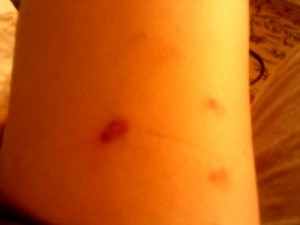Tag: Ringworm
Ringworm has Nothing to do with Worms
A reader left a comment on another article asking us to explain the origin of ringworm. Because ringworm is often…
Ringworm: Five Facts
Ringworm (also spelled “ring worm”) is of intense interest to people, probably because the problems associated with ringworm are very widespread. At one point or another, you are likely to experience an issue related to ringworm, or at least you’ll know someone who is afflicted by this misleadingly-named human ailment. Since ringworm is the object of so much concern, we decided to compile this list of facts about ringworm. We have selected the following five facts about ringworm based on how interesting or surprising we think they are, not necessarily because they are the main features or most notable aspects of ringworm. Check out another article for a more general overview of ringworm.
Can You Get Ring Worm from Ticks?
Ringworm is most often transmitted through damp areas such as public showers and locker rooms. The second most common means of contracting ringworm is from pets.
Ringworm Cures
Oral ring worm treatment options include griseofulvin (Fulvicin, Grifulvin, and Gris-PEG), terbinafine, itraconazole (Sporanox), and fluconazole (Diflucan). When used properly, these treatment options will not have a negative effect on the liver.
Could My Skin Infection Actually Be Ringworm?
If you have a round swollen red ring on your skin and the inside of it appears to be flaking, you might have ringworm. But don’t panic. Ringworm isn’t an actual worm. Ringworm is a fungal disease of the skin and hair.
Do Skin Parasites Exist?
Another type of worm that could possibly end up on the skin, although it cannot survive there, is the pinworm. Pinworm is easy to contract through infected food and water. Pinworms can be easily passed from an infected person to a non-infected person through bathroom stalls and dirty hands.
Ring Worm Pictures
If you are not sure about what ring worm (ringworm) looks like, there are a number of websites that offer pictures of ringworms. The most reliable images, however, belong to medical websites and other health related websites.
How Do You Get Ring Worm?
The worm takes the shape of a ring, hence the name ringworm. Other symptoms of ringworm include sores, itching, and reddened skin. Ringworm can appear on any area of the skin, even the groin area or the feet.
What Do Cat Worms Look Like?
Ringworm isn’t a worm, but rather a skin fungus. The fungus is shaped like a worm and it can be found on your cat’s skin.
What Are The Different Treatments for Ringworm?
Ringworm can be treated fairly easy with most medicated shampoos or oral medications, as well a number of prescription creams. When using most types of ringworm treatment options, symptoms typically disappear within four weeks of treatment.
Do Worms Attack the Skin at Night?
There are several conditions that are commonly called “skin worms” including ring worm and Morgellons disease.
Types of Skin Worms
Skin Worms are not actual worms on the skin, although the skin plays a major role in these conditions or “parasites.” There are several conditions that are commonly called “skin worms.” These include ring worm and Morgellons disease.
What is Ring Worm?
Ring worm is caused by a fungus that creates a ring on the skin. The ring happens to look like a worm.
How to Get Rid of Ring Worm
Depending on the type of ring worm, your doctor may prescribe oral medication, topical medication or both. The most effective topical anti-fungal treatments are creams that include clotrimazole, ketoconazole, miconazole or terbinafine.
Skin Worms
Some of the most common types of parasitic worms do more than cause an upset stomach or fatigue. They can cause skin rashes, blisters on the skin, and intense itching.
Belly Worms
Some people refer to human parasites as “belly worms” and ringworms as “circle worms.” Some people even believe that “belly worms” actually live in the belly button and they also believe that “circle worms” are actually “worms.” Neither is true. The truth is, belly worms are called “parasites” and they do not live in the belly button (as some people may believe), but rather deep inside of the stomach and the intestines of humans and animals.
Ringworm or Ring Worm, It’s Not a Worm at All
Ringworm, sometimes called ringworms, ring worm or ring worms, isn’t actually a worm at all. Ringworm is a highly contagious fungus.





